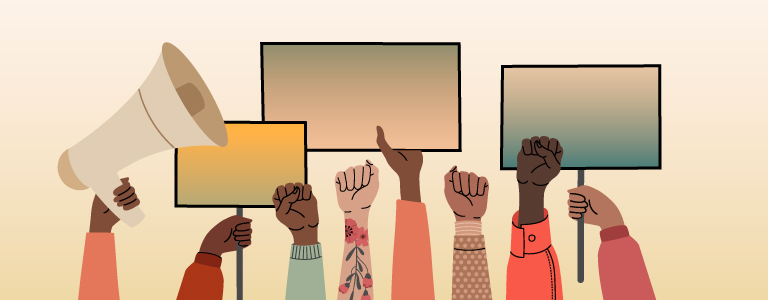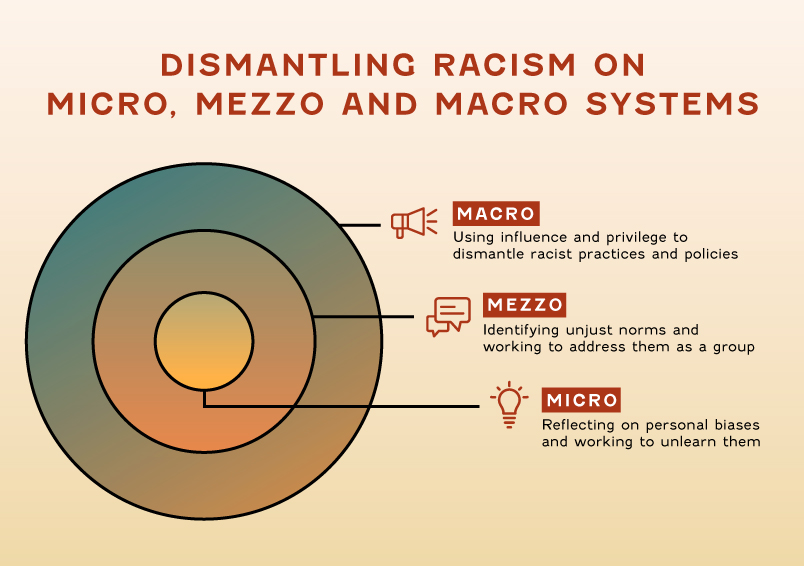How to Be Anti-Racist: A Social Worker’s Perspective

With the rise of viral videos displaying police brutality and other racial injustices, people across the country are being forced to confront the reality of systemic racism and are committing to the work of dismantling white supremacy.
“A year ago, we would not have dreamed of the opportunities coming from this movement,” said Barbara Solomon, a California Social Work Hall of Distinction inductee, in a panel about addressing whataboutisms in anti-racist social work practice hosted by the California Social Welfare Archives.
“People of all colors are in the streets saying, ‘This shouldn’t happen, what can we do?’” Solomon said.
“Activists have argued that being a bystander to racism is an act of racism itself because choosing to stand by while benefiting from unequal systems of power enables violence that irreparably harms people of color.”
With Black Lives Matter gaining momentum as possibly the largest movement in U.S. history, activists have argued that being a bystander to racism is an act of racism itself because choosing to stand by while benefiting from unequal systems of power enables violence that irreparably harms people of color.
“In a racist society, it is not enough to be non-racist, we must be anti-racist,” author and activist Angela Davis famously said.
People who are new to the cause — particularly white people learning to become better allies to people of color — can draw upon the social justice frameworks that social workers use to question and solve problems at every level of society to create change: individual, social and structural.
What Is Anti-Racism?
Anti-racism is the practice of opposing and dismantling social, cultural and structural instances of racism.
Being anti-racist means committing to identifying how racism manifests in social and cultural norms and how to address racism at the individual and structural levels.
“The work is ongoing,” said Renee Smith-Maddox, clinical professor and diversity liaison at the USC Suzanne Dworak-Peck School of Social Work. “You have to learn and unlearn some of the things that you understand about a racialized society and your role in it.”
No one is born a racist or anti-racist. It is a result of the history of race and racism in the United states, our experiences and the choices people make. Even when a person’s biases are unconscious, their behaviors and attitudes can still be racist and wield harm against people in marginalized communities.
“Being anti-racist means committing to identifying how racism manifests in social and cultural norms and how to address racism at the individual and structural levels.”
As an educator, “you cannot teach and ignore what’s happening in the real world,” Smith-Maddox said. “It’s so important to be aware of the current events that are happening around us because it becomes the lens [through] which we can look at problems and how they manifest themselves in our society.”
How to Practice Anti-Racism Every Day
“We owe it to ourselves to create the conditions for people to understand how to disrupt racial trauma, discrimination and exclusion,” Smith-Maddox said. “By no means do I think this happens overnight, but that’s what we’re training our students to be — changemakers.”
Using the social work micro-mezzo-macro framework, people can identify activities, behaviors and learning opportunities at each level of society that can be used to dismantle racism: individual growth, group interactions and large-scale systems or policies.
For example, much of the mezzo-level work begins with people confronting their own social circles, even when it’s uncomfortable.
“You can’t speak truth to power if you don’t speak truth to your friends and colleagues,” said Alex Norman, California Social Work Hall of Distinction inductee who also participated in the “whataboutisms” panel with Solomon. “If we are true to our social justice [work], you look at equality for everyone, even when they’re not in the room.”
Smith-Maddox says it’s essential to create safe and brave spaces for people to grow and learn from their insights, oversights and mistakes.
“You have to create spaces for intergroup dialogue and strive for new levels of understanding, relating and action” she said. “In reality, this is hard work and you won’t always get it right. Anti-racism is practice and a process. It requires active engagement.”
Smith-Maddox provides advice for addressing racism at the individual, organizational and community level, including questions to foster intergroup dialogue and ideas for pursuing social change:
Examples of Anti-Racism at Micro-Mezzo-Macro Levels

Micro Level: Reflecting on personal biases and working to unlearn them
QUESTIONS FOR SELF-REFLECTION
- When thinking about a racial incident you experienced:
Who was I in the situation, how did or didn’t I contribute and why? What did I leave with? - When connecting with your personal history:
What values was I taught and which values have changed over time? What values do I want to have? - When considering power and position:
What different decisions can I make and why? What is my sphere of influence? How can I facilitate change? - When seeking direction for change:
How can I grow in this area? Why do I feel in opposition to a new perspective? - When identifying opportunities for learning:
What can I learn from others? What can I learn about my impact on others?
STRATEGIES FOR MICRO-LEVEL CHANGE
- Speaking up about racism, microaggressions and racial injustice.
- Journaling about thoughts and experiences with racism.
- Recognizing your emotions and reactions to anti-blackness situations.
- Reading books, listening to podcasts or watching movies/documentaries about racial justice.
- Completing a training or course on anti-racism, micro-aggression and unconscious bias.
- Documenting your commitment to promote anti-racism, racial equity and social justice.
Mezzo Level: Identifying unjust norms and working to address them as a group
QUESTIONS TO ASK YOURSELF AND OTHERS
- What can I learn from the other people in the room?
- How can we establish a safe, nonjudgmental environment?
- How can we create a solution-based space to foster dialogue?
- What effect do I have on the people around me?
- What experiences can we reflect on together?
STRATEGIES FOR MEZZO-LEVEL CHANGE
- Inviting a friend or family member to organize with you.
- Joining an anti-racism book club.
- Learning how racism affects the health of those around you.
- Having difficult conversations in-person or online.
- Calling out racism when you see it at home or at work.
Macro Level: Using influence and privilege to dismantle racist practices and policies
QUESTIONS TO ASK ABOUT ORGANIZATIONS OR SYSTEMS
- What are the values of this organization or group?
- Who benefits from the structure of this organization?
- What influence do I have that I can leverage for good?
- Who is marginalized or shut out by the structure of this organization?
- What processes can we change to be more equitable and accessible?
STRATEGIES FOR MACRO-LEVEL CHANGE
- Calling representatives to support and promote racial justice in your community, city or state.
- Raising awareness about racial equity in your workplace.
- Joining a diversity, equity and inclusion committee.
- Participating in elections, petitions and protests promoting racial and social justice.
- Writing op-eds, blogs or articles that advance racial equity.
- Collaborating with organizations dedicated to advancing racial equity and social justice.
Being an Ally to People of Color
Being an ally means supporting marginalized people by lending privilege and resources to pursuing social justice. Instead of trying to lead the charge toward equality themselves, white people can elevate the voices and needs of people of color by decentering their own voices and creating space for others to have power, resources and affirmation.
“When you bring others into the environment to talk about their lived experiences, you realize they are experts in their own experience,” Smith-Maddox explained.
She also emphasized that allyship is a long-term commitment, not just a checklist of activities that allies can complete.
“We have to be willing to listen and learn. You have to be prepared to do the work. This work takes courage. You have to be willing to say, ‘This is my practice. This is what I do, no matter what,’” Smith-Maddox said.
“Do it not from guilt; do it because you know it’s the right thing to do.”
When choosing to adopt a new cause, Smith-Maddox also recommends: “do it not from guilt; do it because you know it’s the right thing to do.” Instead of seeking affirmation that you’re doing a good job of being an ally, focus more on whether you’re learning and effectively stretching yourself to understand the struggle for racial justice. Instead of worrying about getting it right every time, draw upon humility to gain a better understanding of how we can collaborate to address the complexities and challenges related to race and racism.
“People want sincerity, consistency, authenticity, transparency, and action” Smith-Maddox said. “Can you do that, and work with people of different races and intersectional identities? Can you listen to the lived experiences of others? Can you actively engage in antiracist work?”
For Smith-Maddox, an anti-racism practice requires people to be conscious of the changing landscape. She says it’s critical for educators to create the conditions to talk about racism and racial equity as well as facilitate meaningful dialogues with their students and colleagues about ways to advance racial equity and promote positive and lasting social change.
“We have an opportunity to train the next generation of changemakers that could show us why becoming antiracist is essential and what we can do about racism in our society,” she said. “We have no choice now but to do it.”
Additional Resources About Anti-Racism
Anti-Racist Reading List from Ibram X. Kendi, Chicago Public Library: curated list of books from the author of How to Be Anti-Racist, designed “for people beginning their anti-racist journey.”
Being Anti-Racist, National Museum of African American History and Culture: guide to discussing race and anti-racism, including activities, talking points and self-reflection ideas for allies.
Cracking the Code, World Trust: film designed for dialogue by sharing people’s perspectives on the causes and consequences on systemic inequities.
#DoTheWork Course, Rachel E. Cargle: free, 30-day online course for learning how to be a better ally to Black women.
How to Be Anti-Racist, Ibram X Kendi: New York Times–bestselling book from the National Book Award–winning author about identifying and rethinking racist beliefs and social change.
Research Guides: Diversity, Equity & Inclusion: Background/Best Practice, University of Southern California Libraries: landing page for resources recommended by the university, including books, webinars, academic journals and trainings for students and faculty.
The 1619 Project, The New York Times: ongoing project created by Pulitzer-winning reporter Nikole Hannah Jones to reframe American history by placing the consequences of slavery and the contributions of Black Americans at the center of the narrative.
The Guide to Allyship: open-source guide for helping people learn how to become better allies to people with marginalized identities.
The Reality of Diversity, Gender, and Skin Color: From Living Room to Classroom, Finney, K. & Fitzgerald, T: book of personal narratives and social observations that “gives voice to the experiences of marginalized individuals, illuminating the impact of oppression, ostracism, and hate on mental health and wellness.”
Citation for this content: The MSW@USC, the online Master of Social Work program at the University of Southern California.


